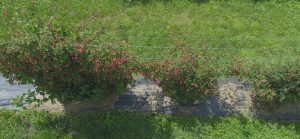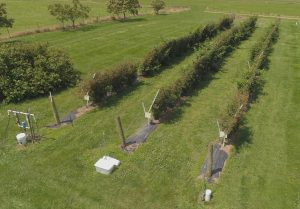This story also appears in our University of Missouri College of Agriculture, Food and Natural Resources’ Agricultural Research Center Magazine. Stop by your local Research Center to pick up a copy! You can view the magazine online by clicking here: Road to Discovery.
The Southwest Research Center is home to a number of specialty crop projects, ranging from elderberries to pawpaws. That research includes a blackberry project led by Patrick Byers, a field specialist in commercial horticulture for MU Extension in Webster County.
Byers is focused on researching blackberries grown in a trellis system. The project includes multiple blackberry cultivars and Byers has been able to showcase how a trellis can be extremely beneficial to blackberry growers.

“The trellis technology is not particularly new,” Byers said. “This design was developed several years ago – it was just never widely adopted by Missouri farmers. We’re working to change that. This research is just a small part of the broad spectrum of specialty crop research that takes place at the Southwest Research Center.”
Byers’ main goal was to develop a demonstration site where farmers could actually see the operation firsthand. He put out a survey and found individuals were extremely interested in seeing blackberry production.
“Farmers are generally willing to adopt technology, but they’re more willing and more comfortable if they can see it in action,” Byers said.
The trellis system is designed to overcome some of the challenges of profitable blackberry production and changes the way the plants grow. With a trellis, a farmer can control plant size, height, cane spread and productivity, stimulate lateral cane growth, thin out weak canes, alter fruiting time, improve insect and disease control, increase harvest efficiency, and make picking more enjoyable.
“The biggest challenges related to blackberries are winter damage and insect and disease pressures,” Byers said. “The trellis system allows you to lay the plants down
in a horizontal position on the ground during the winter months, as well as cover the plants during harmful weather conditions. On the insect front, blackberry farmers have to watch out for fruit flies and Japanese beetles. While it’s tough to fight against insect pests, having the opportunity to effectively cover the berries with protective insecticide sprays helps mitigate that threat.”
There are three types of trellises: a two-wire trellis, a supported hedgerow trellis and a shift trellis. Byers uses a shift trellis at the Southwest Research Center. While the
shift trellis is more expensive than the other two options, that trellis does an excellent job with protecting the berries from winter hardships and insect issues.
Byers has seven different varieties at Southwest: Natchez, Traveler, Osage, Ouachita, Apache, Triple Crown and Freedom. Each of the seven ripen at different times, giving Byers an opportunity to showcase what the growing and harvest season looks like for several cultivars.

Byers planted three rows of blackberries, and each row is 125 feet long. The project is set up as a replicated trial.
“Harvest season typically begins around the beginning of June for the early ripening blackberries,” Byers said. “There is good demand for those blackberries as there are fewer problems with pests than the ones that ripen later in the summer. Our harvest season actually runs through mid-August.
“We want to help farmers understand what their choices are. Finding the right blackberry for their farm is one of the most critical decisions that a farmer makes when they establish a planting.”
The project, funded through a USDA/Missouri Department of Agriculture specialty crop block grant, was initiated in 2016. Byers had his first harvest in 2017 and the next year was his first full crop.
“I’m really excited about the data so far,” Byers said. “In our first full harvest, we ended up with 20 pounds of blackberries per plant in some plots and several of our plots exceeded that. That’s a very respectable yield.”
Byers has taken the blackberry research to the public in a variety of ways, too. He hosted four field days the first year and has hosted another 15 since then, many of which were located at the Southwest Research Center. He has also partnered with the Webb City Farmers Market. There, Byers has promoted locally grown blackberries.
Byers has also sent blackberries to local food pantries. He has tried to share that message through other programs as well, including cooking demonstrations and tastings.
“We’ve taken the blackberry message across the state,” Byers said. “We’re doing our best to get the word out.”